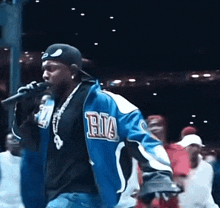When Lana Del Rey made her mainstream debut in 2012, critics didn’t know what to make of her vintage aesthetic and melancholic music. Her rise to fame was attributed to nepotism, with people theorizing that her Dad had paid for her career. She was criticized for her lyrics, her voice, and even her appearance.
Lana has always been mysterious, rarely giving interviews and giving vague answers that only lead to more questions. Her music, unlike anything else on the charts, left critics wondering if she had a place in the modern music industry.
But despite all this, Lana received critical and commercial success, becoming one of the most popular current artists and attracting fans from across the world. Critics have often wondered how she was able to have mainstream success, and described her as being caught up in her own world. But when examining Lana's discography, it becomes obvious why her music captivates millions.
Image Credit: Jaguar Cars MENA via Wikimedia
Let us slide into your dms 🥰
Get notified of top trending articles like this one every week! (we won't spam you)Lana Del Ray
“Lights, camera, action!”
Although it’s often overlooked in Lana’s discography, Lana Del Ray, her first studio album, is essential in understanding her music and self. Back then, she used the stage name “Lizzy Grant” and her career was limited to the underground scene. The title was changed during the album’s release from Lana Del Ray to Lana Del Rey, which became Lizzy’s stage name.
Visually, the album is inspired by a 1950s-1960s dream world, conjuring up images of soda fountains, motels, and Cony Island. Lana’s hair, short and dyed blonde, was kept in a 60’s flip style and she dressed in vintage clothes. This theme of vintage romanticism became a staple in Lana’s signature style.
Musically, Lana Del Ray is experimental, combining alternative folk-rock with pop. Lana’s vocals are simple and she sings about vintage America, gas stations, and doomed romance.
The album had a limited release and was eventually canceled. The album was pulled from streaming services three months after its release when Lana separated from her management.
Lana Del Ray might be the album that receives the least attention, but it doesn’t make it any less important in understanding Lana. It’s the start of her creating a distinct sound with unique visuals to accompany her music.
Take the Quiz: Which Boy K-Pop Band Do You Belong To?
Take this quiz to find out which Korean boy band you would fit into!
Born to Die
“Live fast, die young. Be wild and have fun”
Two years after her first album, Lana Del Rey released two songs on YouTube with homemade music videos (“Blue Jeans” and “Video Games”). After these went viral, Lana recorded and released Born to Die, catapulting her into mainstream attention.
The visuals for the album take inspiration from the 1960s and have a very American style. Lana pulls inspiration from photoshoots of Sue Lyon with heart-shaped sunglasses, Priscilla Presley's bouffant hair and double eyeliner, and old Hollywood glamour. She spoke about how she viewed fashion as a vehicle to further the storytelling in her music.
The music of Born to Die was unlike anything else on the electronic music-dominated 2012 charts. It blends hip-hop with orchestral backgrounds and features numerous ballads. Lana reminisces about vintage America and past loves, sings about toxic relationships, and living fast while having fun.
In some songs, Lana plays up her story-telling, like in “Cola” where she satirizes Hollywood stereotypes, and in “Lolita” where she plays the part of a self-described heartbreaker just looking for fun. These songs don’t represent her as a person, they’re her playing a role to further the storytelling.
Born to Die was the fifth-best-selling album of 2012 but received polarizing reviews. Some appreciated its unique sound while others described the album as repetitive and overproduced. Lana received immense hate during this time, which worsened after a disastrous live performance on SNL.
In 2023 Born to Die was the second album by a woman to spend more than 500 weeks on the US Billboard 200. Retrospective reviews of the album praise it for being ahead of its time and having a distinct sound.
Ultraviolence
“Cause I was filled with poison, but blessed with beauty and rage”
Lana Del Rey’s third studio album, Ultraviolence was released two years after its predecessor, and was a sonic and visual change from Born to Die.
The visuals of the era conjure up images of tumultuous New York in the 1970s. The photos, shot in black and white, depict Lana with her hair dyed black and wearing heavy eyeliner. The album’s title references the controversial 1962 novel A Clockwork Orange, where “ultraviolence” means excessive brutality.
Ultraviolence is a jazz and rock-inspired album with slower tempos and guitar instrumentals. Lana sings about abuse, being misunderstood, and discontent with life. In Born to Die dark themes are hidden behind catchy pop rhythms, but in Ultraviolence they’re at the forefront.
Once again Lana uses character-based songs to add to the album's overall theme. In “Money Power Glory” she plays a materialistic woman, and in “F***** My Way Up to the Top” she parodies the stereotype of women being with powerful men to succeed in the entertainment industry.
The album received mainly positive reviews and was praised for having Lana’s unique style while working in a different genre. However, there was controversy around the title song, where Lana sings “he hit me and it felt like a kiss.” the lyric is a reference to the 1962 song by The Crystals “He HiMe (And it Felt Like a Kiss)” but Lana was still accused of glamorizing abuse. This lyric is still her most controversial.
The album was the best-selling debut week of Lana’s career, selling around 182,000 copies in the US, and had the largest album sales debut of a record artist, before it was overtaken by Taylor Swift’s 1989.
Honeymoon
“Looking for love in all the wrong places”
Honeymoon, Lana’s fourth studio album, and what she described as a “vanity project,” is theorized by fans to be her favorite album she’s created.
The photoshoots for the album are hazy and oversaturated, creating a dreamlike quality that fits the ethereal music. Lana wears large sunsets and poses by palm trees, tropical flowers, and the American flag in a coastal paradise.
The album is a baroque pop album, inspired by hip-hop and ambient. Lyrically Lana references love, but the love feels like an addiction, not something positive. She also sings about abuse, depression, and isolation while also singing about escapism.
In “Burnt Norton Interlude” she recites T.S. Elliot’s iconic poem about universal order and focusing on the present. At its core, the album is about trying to come to terms with personal struggles and escaping problems.
The positive reception of Honeymoon made it Lana’s most critically acclaimed album. It was praised for the reflective lyrics and musical experimentation that showed Lana’s growth as an artist. In the US it sold 116,000 units and peaked at the number two spot on the US Billboard 200.
Lust for Life
“Is it the end of an era? Is it the end of America?”
Lana’s fifth studio album, Lust for Life, is a smorgasbord of everything from Lana’s career, incorporating the distinct sounds from her past albums. It incorporates her signature 1960s visual style and her mix of hip-hop with ballads.
California in the late 1960s is a big inspiration for the era, with the album cover featuring Lana in a vintage dress and with flowers in her hair. For live performances, Lana moved to more comfortable clothes like leggings and sweatshirts.
The album blends hip-hop, folk, and pop and has collaborations with The Weeknd, A$Ap Rocky, Playboi Carti, Sean Ono Lennon, and Stevie Nicks. In the lyrics, Lana sings about the price of fame, the death of the American dream, and love.
While some described Lust for Life as Lana's best album, others felt the album was boring and repetitive. Regardless, this album marks a change in Lana's discography, moving away from facades and towards being herself. The album is also like a crash course in Lana Del Rey through its vintage visuals, melancholy lyrics, and blend of genres.
Norman f**g Rockwell!
“They mistook my kindness for weakness”
Norman f*** Rockwell! is Lana Del Rey’s sixth studio album and her most critically acclaimed, cementing her place as one of the most influential songwriters of the century.
The visuals for the album are breezy and free, referencing beaches, the water, and summertime. Lana dresses comfortably and leaves her hair in a toned-down bouffant. The album's name references the painter Norman Rockwell, who's famous for his social and political commentary on the 1960s through art. Rockwell was a political progressive who dreamt of a more unified America, and on the album, Lana reflects on the current country and dreams of better days.
Norman f****** Rockwell! ranges from psychedelic rock to piano ballads and has been compared to the soft rock sound of the 1970s. Lyrically, Lana sings about the end of the American dream, moving on from men and embracing her inner strength.
She references musicians such as Neil Young and Joni Mitchell and the music scene of the 1970s. In her lyrics she’s darkly optimistic, accepting a world in turmoil and an uncertain future.
The album is Lana's most critically acclaimed, and was nominated for a Grammy for “Album of the Year,” Additionally, the album was put on Rolling Stone Magazine's list of the ‘500 Best Albums of All Time.'
Norman f****** Rockwell! is an authentic album where Lana steps away from rosy nostalgia and into facing the turbulent future.
Chemtrails over the Country Club
“I only mention it cause it was such a scene and I felt seen”
Since its release in 2021, Chemtrails over the Country Club remains one of Lana Del Rey’s most divisive albums. After receiving public scrutiny for public statements, Lana privated her social media accounts, meaning the album received little promotion.
The visuals are summery and toned down compared to previous eras. Lana’s hair is wavy ash blond, and she wears sundresses and pearls as she poses in vintage cars.
Chemtrails over the Country Club has a rustic sound, combining country folk and Americana. Lana sings about nostalgia and romance and reflects on her life with a newfound positivity. The lyrics are her most personal yet, reflecting on her early career, her family, friends, and self-acceptance.
The album was praised for its vulnerability and unique style, while others felt the album was boring at times, due to its slow pacing and lack of upbeat pop tracks.
Blue Banisters
“Let me show you how sadness can turn into happiness, I can turn blue into something beautiful”
Seven months after its predecessor, Lana Del Rey released Blue Banisters. The album had minimal promotion, and the original album cover, a selfie, was criticized so much that a redesign was issued. The final cover is an homage to Tracy Nelson’s 1973 album Poor Man’s Paradise.
During the era, photoshoots were kept simple. Lana posed with her sister, her friends, and her pets. All the photos depict her at home, keeping her hair natural and wearing sundresses.
The album is a folk, jazz, Americana, and pop fusion with simple instrumentals and ballads. The lyrics are less nostalgic, Lana sings about the pandemic, quarantine, and her body image. She’s vulnerable as she sings about her family, friends, and thoughts about the future.
Blue Banisters was praised for its deeply personal lyrics and the relevance of the themes in the music.
Did you know there’s a tunnel under Ocean Blvd?
“Don’t forget me/Like the tunnel under Ocean Blvd”
Did You Know There’s a Tunnel Under Ocean Blvd? is Lana Del Rey’s ninth studio album, combining musical experimentation with raw lyrics.
For photoshoots, Lana posed by hotels and with bikers, conjuring up images of rural America. On the album cover, Lana wears bows in her hair and poses in black and white photos which are contrasted by oversaturated photos of flowers. For live performances, Lana wore floral dresses and a modernized take on her signature bouffant.
Did You Know There’s a Tunnel Under Ocean Blvd? is Lana’s most experimental, while also being personal. One song, “Judah Smith Interlude” is a recording of a passionate sermon done by Pastor Judah Smith with instrumentals in the background.
Other songs switch genres, like “A & W” which begins as a quiet folk song and ends as a trap song. Other songs like “Fingertips” don’t have a chorus or consistent melody, and feel like a reading of Lana’s diary. The album goes from hopeful love songs to quiet ballads and samples of her previous work all put together into a cohesive album.
Lana sings about death, and reflects on her legacy, and in the title track, she begs the listener to remember her. At times the album is hopeful, with Lana singing about future love and her family, but at other times she sings about the destructive power fame has.
The album was celebrated for its intimate lyricism and called her most complicated album. Did You Know There's a Tunnel Under Ocean Blvd? received two Grammy nominations for “Album of the Year” and “Best Alternative Music Album.”
Final Thoughts
When Lana Del Rey debuted, her distinct style made mainstream success seem unlikely. Yet, she connected to millions, and her impact on pop culture is now undeniable. Artists such as Taylor Swift, Billie Eilish, and Olivia Rodrigo all cited Lana as a musical influence. Her music is at the heart of the ultra-feminine coquette subculture, which went viral in 2023.
While Lana’s music might be glamorous and cinematic, it doesn’t lose its relatability. She reminisces about past loves, romanticizes simple things like going to gas stations, and sings about struggling to find her place in an uncertain world.
While Lana's style is unique to her, the themes she sings about are struggles and joys that most people experience, and she does it in a cinematic way. Through her nine studio albums, Lana Del Rey has proven herself to be one of the most important singer-songwriters of the 21st century.
Image Credit: Ralph_PH via Wikimedia











.jpg)

